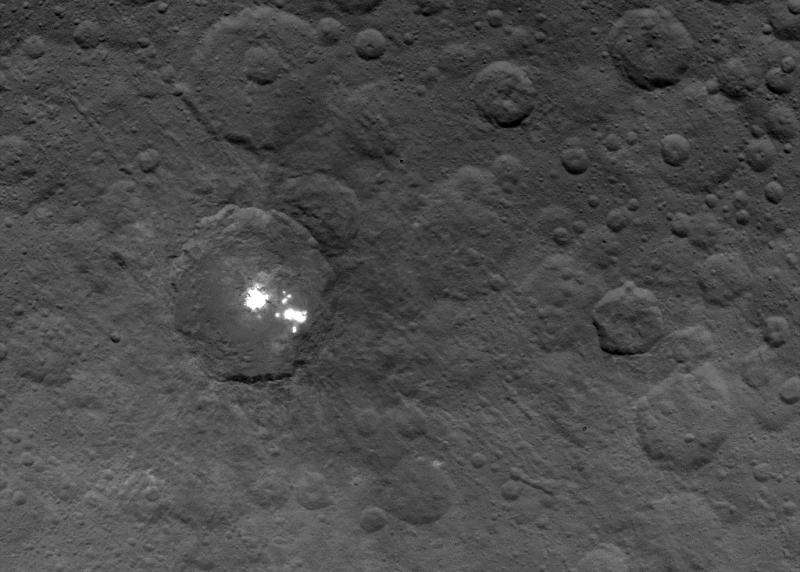What's up with Ceres' mysterious bright spots? Reply hazy, ask again later

The crater that contains those puzzlingly bright spots on Ceres may harbor an equally puzzling haze. Or not. The hints of haze on the dwarf planet, seen in some of the images coming from NASA's Dawn spacecraft, add another intriguing twist to Ceres' mysteries.
The hubbub over haze arose this week during the Exploration Science Forum at NASA's Ames Research Center in California. For months, Dawn's scientists have been observing – and trying to make sense out of – unusually reflective spots within Ceres' craters that show up when the asteroid turns into the sunlight. The team has speculated that they could be frozen pools of water ice, or patches of light-colored, salt-rich material.
The brightest spots are known collectively as Spot 5, and sit inside Occator Crater on Ceres. Dawn's principal investigator, Chris Russell of the University of California at Los Angeles, told the forum that some type of haze could be seen inside the crater at certain times of Ceres' day, according to reports from Nature and the Planetary Society. Nature quoted Russell as saying the bright spots "could be providing some atmosphere in this particular region of Ceres."
Last year, scientists with the European Space Agency's Herschel mission reported detecting signs of water vapor rising from Ceres' surface, and it would be tempting to suggest that the water vapor is emanating from bright icy spots and creating the haze. That would strengthen Ceres' status as the only asteroid with a significant atmosphere and a subsurface reservoir of water, and stoke speculation about life on Ceres.
However, Russell told Universe Today that it's way too early to give in to temptation.
"I was speaking from less than a handful of images, and the interpretation of the images is disputed by some team members," Russell said in an email. "I would like the debate to go on internally before we make a pronouncement one way or the other. I of course have my personal opinion, but I am not always right."
Russell said the ice-vs.-salt debate is continuing. "I originally was an advocate of ice, because of how bright the spots seemed to be," he said. However, the bright material's albedo, or reflectivity factor, is about 50 percent – which is less than Russell originally thought. "This could be salt and is unlikely to be ice. I think the team opinion is now more in line with salt," he said.
Either way, Russell doesn't see any way for the spots to form without internal activity on Ceres. "Thus, the very existence of the spots tells us that there is some active process going on," he told Universe Today.
Will we ever know if the haze is for real? Or what the spots are made of? As the Magic 8-Ball might say, "Ask again later." The Dawn spacecraft recently recovered from a mechanical glitch and is gradually descending to a closer mapping orbit, around an altitude of 900 miles (1,500 kilometers). That will provide a much better look at Occator Crater and what lies within.
"Eventually I am expecting the spectral data will unambiguously tell us what has happened to the surface," Russell said, "but it is a little too soon to be sure."
Journal information: Nature
Source: Universe Today





















